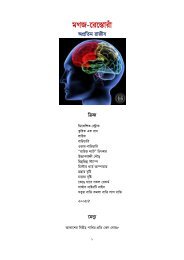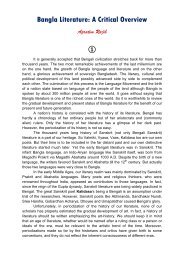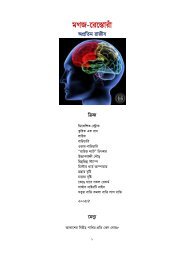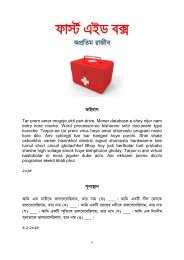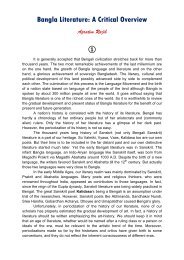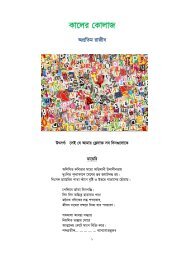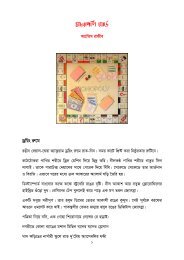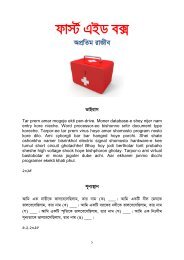Literature-Critique
You also want an ePaper? Increase the reach of your titles
YUMPU automatically turns print PDFs into web optimized ePapers that Google loves.
39<br />
agitation against the injustice done by the British rulers gradually increased and it<br />
eventually led the nation to its independence. That disrupted era of struggle for<br />
freedom found its best artistic exposure in Nazrul’s poems. He gave birth to a typical<br />
style and diction, which conveys the tone of violent protest.<br />
Nazrul is commonly known in Bengal as the ‘Rebel Poet’, as the epitome of<br />
Bengali nationalism and independence. Perhaps no other poet of the world has<br />
expressed so artistically the firm voice of protest against tyrant rulers. But his entire<br />
reputation does not lie merely in these traits. He was also a poet of love, a classical<br />
musician and a skilled translator of Persian and Arabic poems. Not only that; he also<br />
brought Middle Eastern and Hindustani artistic flavor into our literature.<br />
His immortality in Bangla literature is mainly for his first book of poems<br />
Agnibina (The Harp of Fire). However, he has another quite similar work titled Bisher<br />
Bashi (The Flute of Poison).<br />
“Bidrohi” (“The Rebel”), which is widely recognized as his immortal<br />
masterpiece, is a great example of pluralistic ideas. Themes and characters of<br />
Indian, Greek and Middle Eastern mythologies are assimilated here. He professed<br />
his vision of himself as a poet of love and rebellion in the following line of the poem,<br />
“A curbed bamboo-flute is in my one hand, in the other a war-drum.”<br />
(Translated by the author)<br />
In “Raktambardharini Ma” (“Red-colored Mother”) and “Agamani” (“The<br />
Coming Deity”), he presents goddess Durga symbolized as the opponent to demonlike<br />
imperial power.<br />
“Kheyaparer Tarani” (“The River Boatman”) is based on an Islamic legend.<br />
Nazrul presents Prophet Mohammed and his followers as social reformers and<br />
propagators of a new age. The following line of the poem makes it a masterpiece of<br />
anti-communal literature –<br />
“The helmsman sings a Shari song: La sharik Allah.”<br />
(Translated by the author)<br />
This poem influenced some later Muslim poets like Farrukh Ahmad, although in<br />
entirely different and limited sense.<br />
It also needs to be said that he was not simply a preacher of noncommunalism;<br />
he inspired the Bengali Muslims to revaluate their cultural identity. He<br />
remarkably made an imprint of Hindu myths and philosophies on the psyche of his<br />
community.<br />
Nazrul believed in a deity; but he sometimes expressed his antagonism to that<br />
deity to express his revolutionary thoughts. Many of his poems expose the mind of a<br />
Renaissance poet who is in a dilemma between theistic and its contradictory beliefs;<br />
for example, in “Dhumketu” (“The Comet”) –<br />
“And I eat the Creator chewing.”<br />
(Translated by the author)<br />
Or in “Bidrohi” –<br />
“I’m the rebel Vrigu, and shall mark my footprint on God’s breast.”<br />
(Translated by the author)<br />
“Jhar” (“Storm”) is a poem professing the poet’s political (implicitly Marxist)<br />
aim.




